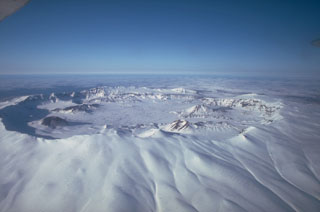Report on Okmok (United States) — February 1988
Scientific Event Alert Network Bulletin, vol. 13, no. 2 (February 1988)
Managing Editor: Lindsay McClelland.
Okmok (United States) Ash from new vent
Please cite this report as:
Global Volcanism Program, 1988. Report on Okmok (United States) (McClelland, L., ed.). Scientific Event Alert Network Bulletin, 13:2. Smithsonian Institution. https://doi.org/10.5479/si.GVP.SEAN198802-311290
Okmok
United States
53.43°N, 168.13°W; summit elev. 1073 m
All times are local (unless otherwise noted)
On 26 February, ash emerged from a new vent at the SW base of the cone, while the cone's previously active vent was limited to steaming (table 1).
Table 1. Reports of activity at Okmok, January-February 1987, compiled by John Reeder from James Dickson and Tom Madsen, Aleutian Air Ltd.
| Date | Time | Observer | Activity |
| 08 Jan 1987 | 0900 | Dickson | 600-m billowing white steam plume seen from boat just N of Unmak Island. |
| 14 Feb 1987 | 1600 | Madsen | Continuous steam and ash emission; cloud to 1,400 m altitude (about 500 m above the caldera rim), drifting 70 km NW in a 55 km/hour wind. |
| 26 Feb 1987 | 1730 | Madsen | Onset of black plume emission, from a new vent at the SW base of the cone; plume dirfted about 35 km SSW at 1,350 m altitude; only white steam emerged from the cone's previously active vent. |
Geological Summary. The broad, basaltic Okmok shield volcano, which forms the NE end of Umnak Island, has a dramatically different profile than most other Aleutian volcanoes. The summit of the low, 35-km-wide volcano is cut by two overlapping 10-km-wide calderas formed during eruptions about 12,000 and 2050 years ago that produced dacitic pyroclastic flows that reached the coast. More than 60 tephra layers from Okmok have been found overlying the 12,000-year-old caldera-forming tephra layer. Numerous satellitic cones and lava domes dot the flanks of the volcano down to the coast, including 1253-m Mount Tulik on the SE flank, which is almost 200 m higher than the caldera rim. Some of the post-caldera cones show evidence of wave-cut lake terraces; the more recent cones, some of which have been active historically, were formed after the caldera lake, once 150 m deep, disappeared. Hot springs and fumaroles are found within the caldera. Historical eruptions have occurred since 1805 from cinder cones within the caldera.
Information Contacts: J. Reeder, Alaska Division of Geological and Geophysical Surveys (ADGGS).

